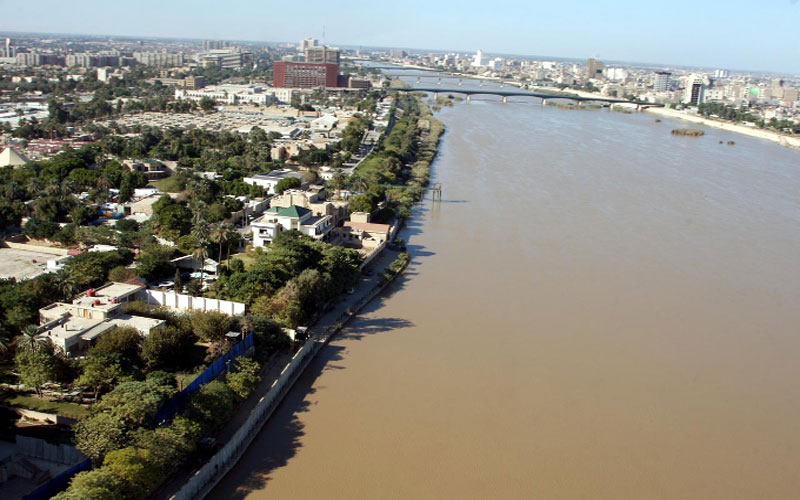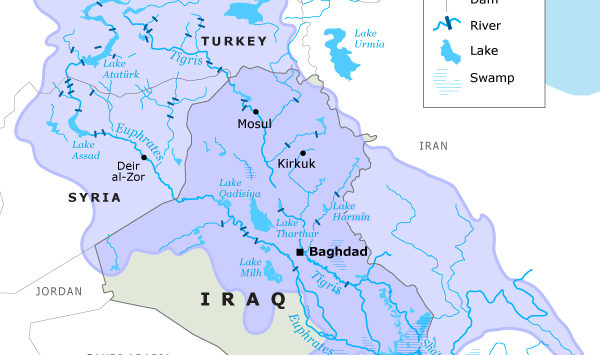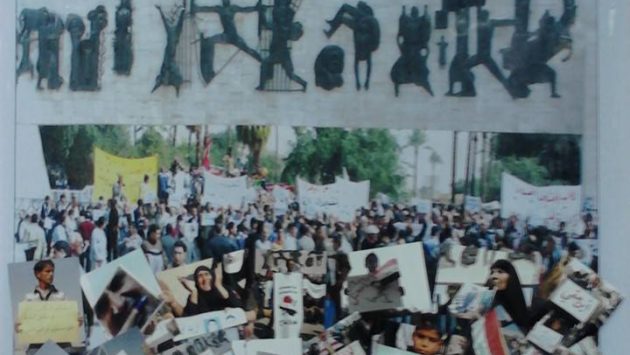The Shared Responsibility Behind the Pollution of The Tigris River in Baghdad
In the following article, we review a number of points related to water pollution in Baghdad. We talk in detail about the threats posed by the continued pollution of the Tigris River within the borders of the capital, and the environmental, social, health and economic consequences for residents. Ultimately, we aim to develop treatments and solutions that can improve the health of the river and ensure the sustainability of the resources it provides. We do not cast blame for the problem on any single group or party, rather we understand the well-being of the Tigris to be a common concern, a shared environmental issue. After all, the Tigris is a crucial resource for all Iraqis and thus ensuring its well-being is a responsibility that everyone bears, from governmental institutions, ministries and related bodies, to civil society and its organizations, to citizens generally (especially those living on its banks). Also included in this circle of responsible agents are profitable commercial projects such as casinos, tourist resorts, factories and private factories. All of this will be detailed in the review below.
The State of the Tigris River in Baghdad Today
There is no doubt that water is one of the most precious gifts of nature, and the most important for sustaining life. Water is required for almost every human activity: drinking, various municipal uses, crop irrigation, industry, energy generation, navigation and entertainment.[1] However, water quality in many large rivers has increasingly deteriorated around the world due to human activity over the past two or three decades.[2] Given this, continual monitoring of water quality is absolutely essential as we must be able to determine pollution levels rivers which provide the world with a major source of water[3].
The Tigris River is one of the largest rivers in the Arab world, with a length of 1900 km, about 1415 km of which extends inside Iraq. It is considered the main source of drinking water in Baghdad, the largest city in the country and the second largest city in the Arab world (with a population of 7.5 million).[4] This article uses the Geographical Information System (GIS) to compare water quality data and related information collected for water quality in the Tigris River, and the distribution of types and forms of pollution in the river water. The information will be presented in the attached maps to facilitate the knowledge of the subject dimensions.[5]
The Tigris River enters the city of Baghdad at the coordinates of 44˚24 ‘E, 33˚36’ N to the north, and divides the city into its well-known Karkh and Rusafa sections. Its length inside Baghdad is about 110 km. The river enters the city of Baghdad after flowing for a long distance, starting from its source in southeastern Turkey, passing through the Syria, and continuing through Iraq by way of Nineveh and Salah al-Din provinces before arriving in Baghdad. The marked difference in the quality of the river’s water between its entry points into Baghdad and its exit from the city is a clear indication of the pollutants it collects during its passage thought he capital. There is no denying the fact that the river reaches Baghdad already loaded with pollutants, but the river runoff after it flows through the urban center is worrisomely higher than it is when it enters. Stated bluntly, what the river suffers inside Baghdad is no less than an environmental disaster, and one that must be stopped.
Even taking into account the fact that the city of Baghdad has the largest population density within all of Iraq, and leads the country in industrial and service activities, this does not explain the vastly higher rates of pollution found there as compared to other similar cities. The pollution of the Tigris in Baghdad also violates the amounts permitted by the World Health Organization. Given the recurrence of droughts and the drop in water levels below their usual levels, water pollution poses a double threat as the lower water levels make the concentration of pollutants in the water even higher.
A reading of the measure of total dissolved solids (TDS) indicates that the rate rises from 678 to 787 mg / liter between the beginning of the river’s entry into Baghdad. By comparing this reading with three basic criteria: the World Health Organization standards, the standards set by the Canadian Council of Minister of the Environment, and the Iraqi standard adopted in 1998, it is clear that the lowest registered percentage of dissolved solids in the river far exceeds all the criteria mentioned, as the permissible limit is 500 mg / liter for potable water. As for water used for agricultural purposes, it should be below 750 mg/l / cm.
The TSS index for total suspended solids also records a reading that ranges between 38.83 in the north of Baghdad and a maximum of 73.45 mg / l in the south, while the maximum permissible limit for this indicator is 33.22 mg / l. According to WHO standards, this reading can be considered dangerous for human use. In addition to what has already been cited, the analyses record the presence of various minerals within the structures of the river’s water in varying proportions. Perhaps the most prominent observed minerals are: Calcium, Magnesium, Chlorine, Fluorine, Sulfur Dioxide, Nitrite dioxide, Ammonia, and Phosphates in addition to Iron, Aluminum and other toxic chemicals. As an example, we reviewed the proportions of Iron in river water, rand found it ranged from 1.16 to 1.37, while the permissible limit is 0.77 mg / l.
Given what studies show, we can conclude that the Tigris River inside Baghdad is polluted at rates much higher than all national and international standards. Sites which use the river irresponsibly currently pose a threat to the lives of all residents. The health problems which arise from using polluted water cannot be avoided simply by limiting use of it, and to date, the water treatment plants are not sufficient to guarantee potable river water. Moreover, high salinity ratios prevent vital agricultural activity, directly contributing to the destruction of crops which in turn lowers productivity. Salinity also reduces the quality of the soil by weakening the overall fertility of the land, and decreases the incentive to invest in a sustainable manner. Water pollution has also contributed to the disruption of economic activity within a large segment of the population; those who once benefitted from the bounties of the river by fishing and farming have been forced to abandon their professions.
Negligence and lack of interest in maintaining water quality has contributed to the failure to meet the population’s need for water, access to drinking water has become a volatile issue and residents are not now able to ensure they will have enough to meet their needs.
Causes and responsibilities:
Many sectors contribute to the deterioration of water quality in the Tigris River. Below we mention some of the most prominent factors we were able to identify:
- Sewage waste: After many heavy water and wastewater treatment plants went out of service, with others becoming quite old, there are an inadequate number of modern treatment plants to cover the growth in need for clean water. Excessive amounts of heavy and wastewater are dumped into the river directly without necessary processing.
- Factories and laboratories: Many government and private factories dump waste from their industrial operations directly to the river without reporting or monitoring amounts, much of the organic and insoluble minerals contained in this waste is toxic. Statistics indicate that there are more than 900 factories located on both sides of the river within Baghdad, including car washes and car garages which often dump oil directly into the river.
- Hospitals and health centers: This sector represents one of the largest sources of pollution in Baghdad, with the largest medical complex located directly on the Tigris River, as well as a number of other smaller hospitals also located along the river banks. These hospitals are centers dedicated to helping and treating the sick, however, too often these hospitals throw their toxic waste directly to the river, contradicting the purpose of their existence. The medical complex in central Baghdad leaks the waste of nearly 1,000 patients daily to the Tigris River, including chemical solutions and dangerous insoluble materials. Among the most important leaks from hospital activity near the river are: formaldehyde, image analysis and display chemicals, methanol and acetone solvents, mercury, and the female hormone estrogen, in addition to large quantities of antibiotics and drugs used to treat cancerous tumors.
- Oil installations: The danger of oil is concentrated in the liquids that leak from them to the river and the surrounding environment. One can clearly observe oil spills near the Al-Dora Refinery, which is due to the negligence in following up on the removal of organic waste from the refinery. This sector also includes thermal stations that play a role in dramatically increasing the water temperatures in the river after using them to cool machines. Drastic rises in temperature is a form of pollution which deprives the river of its capacity to act as a habitat for animals and plants.
- Casinos, restaurants, and tourist resorts: Due to lack of oversight and monitoring, we found a lot of entertainment venues engaging in different forms of environmental pollution, from dumping waste and plastic in the river, to constructing drainage systems which flow into the river directly. The amount of pollution caused by the dumping of waste in rivers can be seen when visiting any of the recreational sites near the river.
- Drains: The discharge of highly saline puncture water directly into the river without isolating it with special drainage lanes is another important source of pollution. The puncture water comes from washing the salty agricultural lands, as the water from the washing is saturated with chemicals, fertilizers and salts, and given its connection to the river water, large concentrations of toxins are found in it.
- Waste and garbage: Heaps of rubbish are piled along the sides of the river, some of which fall into the river. Some citizens also dump their waste directly into the river.
In 2018, Humat Dijlah Association released a study that monitored pollution in the Tigris River within the administrative boundaries of Baghdad. It is available here. All these documents and others issued by official government agencies or research centers confirm that the current toxicity of Tigris River has reached levels which are dangerously high. Urgent action is needed.
[1] K. S. Kannan and V. Ramasubramanian, “Assessment of Fluoride contamination in Ground Water Using GIS, Dharmapuri District, Tamilnadu, India,” International journal of Engineering Science and Technology (IJEST), Vol. 3, No. 2, 2011, p. 1077
[2] O. Altansukh and G. Davaa, “Application of Index Analysis to Evaluate the Water Quality of the Tuul River in Mongolia,” Journal of Water Resources and Protection, Vol. 3, No. 6, 2011, pp. 398-414. http://dx.doi.org/10.4236/jwarp.2011.36050
[3] A. M. Rabee, B. M. Abdul-Kareem and A. S. Al-Dhamin, “Seasonal Variations of Some Ecological Parameters in Tigris River Water at Baghdad Region, Iraq,” Journal of Water Resource and Protection, Vol. 3, No. 4, 2011, pp. 262-267. http://dx.doi.org/10.4236/jwarp.2011.34033
[4] K. W. AL-Janabi, F. N. Alazawi, M. I. Mohammed, A. A. Kadhum and A. B. Mohamad, “Chlorophenols in Tigris River and Drinking Water of Baghdad, Iraq,” Bulletin of Environmental Contamination and Toxicology, Vol. 87, No. 2, 2011, pp. 106-112.
[5] Readings by the researcher Abbas Jawad Kazim




